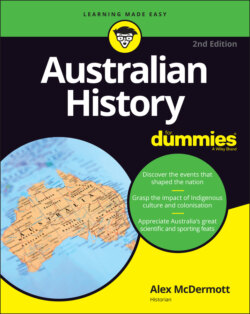Читать книгу Australian History For Dummies - Alex McDermott - Страница 19
Solving the Problems of the World (By Keeping Out the World)
ОглавлениеWhen depression hit in 1891, the sustaining ideas of the long boom — of ever-increasing abundance, technological advancement and continued riches — came undone. The assumption that old-world problems such as class antagonism had been solved turned out to be untrue, as seen in a series of savage strikes that broke out in the early 1890s — on the docks, in the shearing sheds and in the mines of Broken Hill. The various progressive colonial governments came down on the side of the bosses, sending in troops to maintain order and protect the rights and property of bosses and owners. ‘So much for the workingman’s paradise’, said the workers. ‘So much for social harmony and real progress’, said the middle class.
In the end, the middle classes had supported the decision of governments to send in troops against strikers to keep order and maintain public safety. However, they were furious about having to make such a choice at all. Colonial Australia wasn’t meant to be like that: Most people in Australia had spent 30 or so years proudly boasting that Australia was far too progressive to let things like that happen.
From the widespread disillusionment felt by many during the 1890s depression, a series of new factors emerged:
The union movement, which had seen its power largely broken in the strikes, decided it was time to form a political party, get voted into government and change the laws themselves to make them friendlier to workers. From this ideal, the Australian Labor Party was born (see Chapter 11) and, by the end of the first decade of the 1900s, had established itself as the dominant force in Australian politics.
Federation, the idea of forming a new country out of the old self-governing colonies, took on a new momentum after being kickstarted at the ‘people’s convention’ at Corowa on the Murray River in 1893. Federation succeeded largely as a powerful symbol of new unity — ‘a nation for a continent and a continent for a nation’ — which would help colonial Australians move beyond the divisions and struggles that had so divided sections of the community in the 1890s (see Chapter 11).
The idea of a newly federated nation became not simply an end in itself but a means to establish a ‘social laboratory’. Federation would allow Australia to insulate itself from the rest of the world and implement solutions to problems, such as worker–employer conflict and poverty. These problems were apparent in other modern nations (for example, in Britain, the US and France) and had recently become apparent in the colonies. Heavily restricting immigration (with the now-notorious White Australia Policy) and bringing in heavy tariffs (taxes, or customs duties) on overseas imports to protect local jobs and industries were both brought in during the first decade after Federation to achieve this insulation, as were many social reforms (see Chapter 12).
